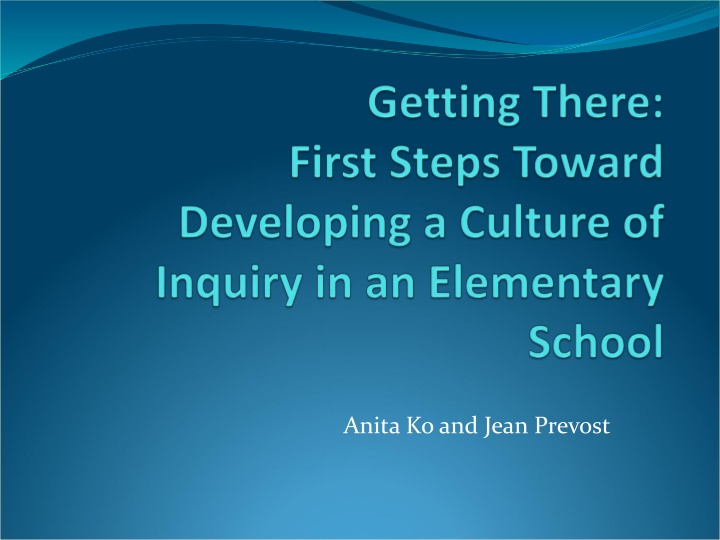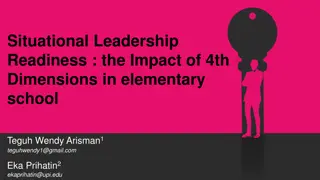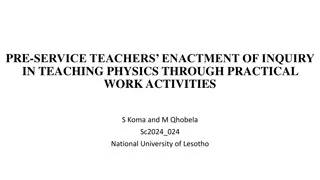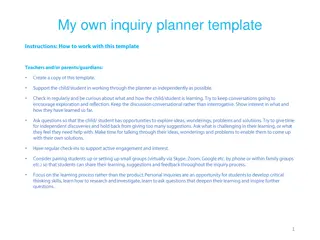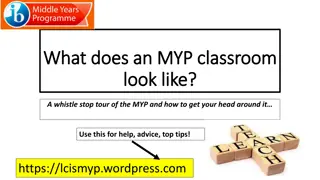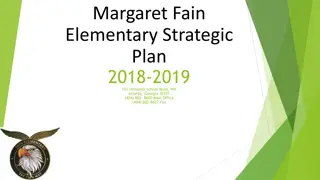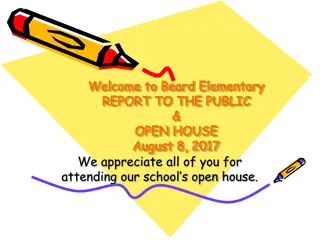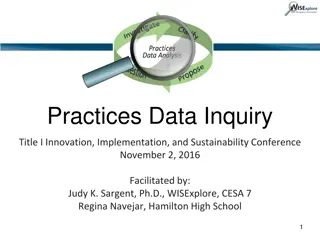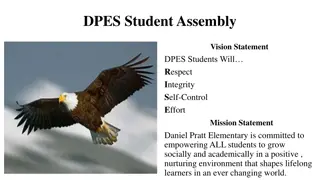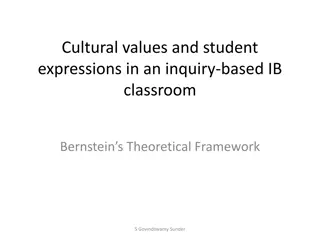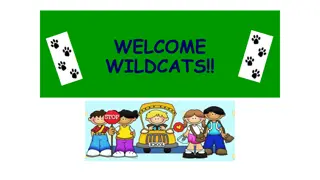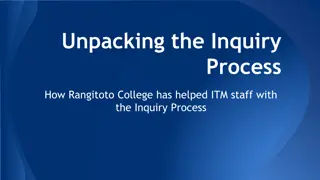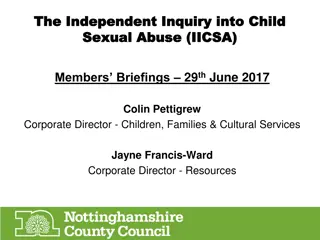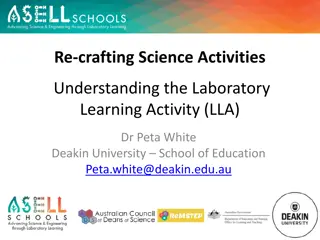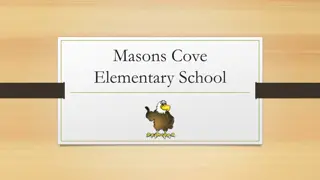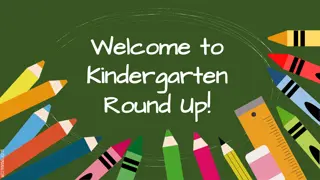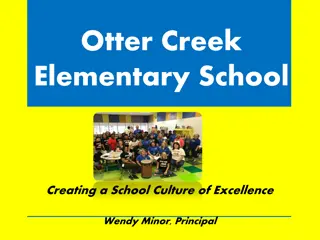Developing a Culture of Inquiry in Elementary School: A Journey Overview
Explore the journey of developing a culture of inquiry in an elementary school through three inquiry cycles. Starting with the introduction of Inquiry Based Learning, sustaining interest, learning outcomes, and evolving questions are discussed alongside examples of inquiry learning at various school levels.
Download Presentation

Please find below an Image/Link to download the presentation.
The content on the website is provided AS IS for your information and personal use only. It may not be sold, licensed, or shared on other websites without obtaining consent from the author.If you encounter any issues during the download, it is possible that the publisher has removed the file from their server.
You are allowed to download the files provided on this website for personal or commercial use, subject to the condition that they are used lawfully. All files are the property of their respective owners.
The content on the website is provided AS IS for your information and personal use only. It may not be sold, licensed, or shared on other websites without obtaining consent from the author.
E N D
Presentation Transcript
Getting there . . . An overview of 3 Inquiry cycles outlining our journey toward developing a culture of inquiry in our school which explore the questions: How did we start? How did we sustain interest? What did we learn? What are our new questions? Some concrete examples of what inquiry learning looks like at different levels in our elementary school.
September 2009 - March 2010 Connect and Wonder A few people in our school began hearing about IBL What is Inquiry Based Learning? Why should we use it? How can we use it?
Investigate Jean (TL) began using Inquiry based learning with two classes and their teachers (Science centered Spiders and Solar System) Anita joined a group working on a teacher inquiry project on Assessment for Learning (AFL)
Construct We connected what we were doing to the learning process outlined in the Alberta Learning Inquiry Model, Focus on Inquiry (2004) We identified similarities in the process to our current practice We identified the main differences to be: RECURSIVE REFLECTIVE COLLABORATIVE
Express Jean and the collaborating teachers shared with administration and with colleagues, both informally and at staff meetings, how the inquiry process was engaging students Anita and other teachers on her team shared the results of their inquiry at the district Professional Growth Council meeting
Reflect We had many discussions on what worked and what we would do differently next time Jean wondered how she could get more teachers interested in trying IBL Anita wondered how to apply the inquiry process with her grade 2 students We noticed and increased level of engagement in both teachers and students New question: How can we begin to build a culture of inquiry in our school?
March 2010 June 2010 Connect and Wonder How can we begin to build a culture of inquiry in our school? How can IBL fit with our school plan?
Investigate More successes with IBL were shared with staff TL shared Inquiry models with staff TL shared articles with teachers and administration, formally and informally Resources on IBL were purchased for the library Staff watched videos on 21stcentury learning like: Stephen Heppell (21stCentury Learning and Death of Education Learning to Change, Changing to Learn Shift Happens
Construct In March our School Planning Council (parents, teachers and administrators) met to begin discussing our school plan Administrators and teachers shared learning around IBL and student engagement Everyone expressed interest in including IBL in our school plan Discussion followed and debate centered around whether IBL would be a goal or a strategy for increasing student engagement
Express Our collaboratively developed school plan for 2010/2011 included the main goal: To improve student engagement The use of Inquiry-based Learning to enhance teaching and learning was listed in the school plan as a strategy for improving student engagement
Reflect With IBL part of the collaboratively developed school plan, parents, teachers and administrators now had a connection to IBL We hoped this connection would help with time and money for professional development around IBL New Question: How do we develop and sustain commitment to the use of the IBL process in our school?
June 2010 June 2011 Connect and Wonder Now that IBL is part of our School Plan . . . Where do we find the time for Pro-D? Where do we find the money? How do we sustain interest?
Investigate How to organize school-based NIDs to include effective Pro-D on IBL How to apply for Pro-D grants from Local Teachers Association to assist with funds How to organize a Collaborative Apprenticeship where teachers are learning together and from each other, creating support and encouraging ownership
Construct The Collaborative Apprenticeship team was established. We applied and received a Priority Funds grant of $3000 to support the Collaborative Apprenticeship We began the school year with the first school-based NID centered around Inquiry -using an Inquiry model, staff pursued their own inquiry, exploring a variety of resources for a better understanding of: What is IBL and how can I use it with my students? -grade teams made plans for their inquiry unit(s) continued
Construct (continued) In advance of the second school-based NID, we used grant money to fund release time for the CA team so they could further explore IBL in preparation for sharing their learning on the second school-based NID The C/A team met for a second time in the Spring and shared learning with grade partners in an afterschool session Staff began to develop the wiki We developed a personalized model for our school based on a combination of the Alberta Learning model and the Points of Inquiry model 95% of staff tried IBL units with their students
Express The CA team members shared their learning with their grade group partners All teachers contributed reflections to the wiki Students shared their Inquiry projects with parents at Parent Nights, with buddy classes, and on class wikis We shared parts of our journey with the PAC and made the wiki available for the School Plan Evaluation Meeting continued
Express (continued) We gave an overview of our Inquiry into IBL at the District Professional Growth Council meeting Jean shared our learning with the District Teacher Librarians We shared our learning with the Minister of Education, the honorable George Abbott, when he visited our school We are here sharing with you!
Reflect IBL works! We notice a definite increase in student engagement when we use IBL Support from administration is key Using the process ourselves helped us to better understand how to use it with students We needed to personalize the model IBL looks different at different levels continued
Reflect (continued) Different styles of IBL accommodate different needs of both teachers and students We like how we can integrate curricular strands into IBL Collaboration is necessary IBL is not predictable or tidy Technology supports IBL, providing tools for learning New Question: How do we assess IBL?
Books Comprehension and Collaboration: Inquiry Circles in Action. Harvey, S. and Daniels, H. (2009) Engaging Readers and Writers with Inquiry. Wilhelm, J. (2007) Guided Inquiry: Learning in the 21stCentury. Kuhlthau, C., Maniotes, L., & Caspari, A. (2007) A Place for Wonder: Reading and Writing Nonfiction in the Primary Grades. Heard, G. &McDonough, J. (2009)
Sites http://cbayinquirylessons.pbworks.com/w/page/30273195/ FrontPage http://goldrushfurtrade.pbworks.com/w/page/38691789/Fr ontPage http://cordovabaysocials4.pbworks.com/w/page/36437627/ FrontPage http://gradethreeinquiry.pbworks.com/w/page/35201794/F rontPage http://grade2inquiry2011.pbworks.com/w/page/35185609/P olar%20bear%20Inquiry http://groundhogs.pbworks.com/w/page/35193188/Ground hog%20Inquiry%20Project
Keeping it Green Rather than providing handouts, we would be happy to email this Powerpoint presentation to you. Please leave your email address with us. Thank you, Anita and Jean
